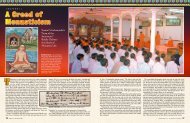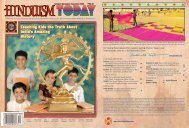Hinduism Today July/August/September 2005
Hinduism Today July/August/September 2005
Hinduism Today July/August/September 2005
You also want an ePaper? Increase the reach of your titles
YUMPU automatically turns print PDFs into web optimized ePapers that Google loves.
courtesy ac mutt<br />
mu devarayan<br />
Ancient and modern: Satellite dishes<br />
sit just behind and above the pillars<br />
of the new Bhairaveshvara Temple at<br />
Sri Kshetra, while in the background<br />
are the present Mutt main building<br />
and the rock cliffs with caves wherein<br />
many yogis have meditated<br />
Marriages and medicine: (above) Sri<br />
Swamiji with couples who were part of a<br />
mass community marriage ceremony sponsored<br />
by the Mutt; (right) The BGS Foundation<br />
of Health Sciences facility, located next<br />
to the BGS Apollo Hospital in Mysore City<br />
m u deva rayan<br />
to keep children of non-resident Indians in<br />
touch with their cultural heritage. It was inaugurated<br />
in 2001 by the then prime minister<br />
of India, Shri Atal Bihari Vajpayee. Sonia<br />
Gandhi, Sai Baba and the Dalai Lama are<br />
some of the dignitaries who have visited. It<br />
has state-of-the-art laboratories and computer<br />
centers for the students. The residential<br />
facilities are fairly luxurious, designed with<br />
the affluent non-resident Indians in mind,<br />
who are the school’s main patrons. Whereas<br />
the ordinary rural school fee per annum,<br />
inclusive of transportation, is $47, here it is<br />
$4,545 per child—slightly more than the average<br />
cost of a private day school in the US.<br />
Most of the students I talked to were happy<br />
with the disciplined life they were leading<br />
in the BGS institutions whether they were<br />
studying as day students or living at a hostel.<br />
Each institution is under the direct charge<br />
of a swami disciple of Swami Balagangadaranathaswami.<br />
Each swami has an office in the<br />
institution and interacts with the faculty and<br />
the students on a daily or a weekly basis. “The<br />
management and supervision of our temples<br />
of learning by the saints is what makes them<br />
stand apart from the other educational institutions,”<br />
Swami Nirmalananda pointed out.<br />
Moral education, though not a part of the<br />
official school curriculum, is taught by the<br />
administrating swami, along with meditation,<br />
chanting and yoga. At these sessions,<br />
mantras such as “Guru Brahma, Guru Vishnu,<br />
Guru Devo Maheshwara” are chanted<br />
by thousands of students and their teachers.<br />
At many schools, huge halls have been constructed<br />
for teaching meditation and yoga,<br />
and holding satsangs and singing bhajanas.<br />
At some schools, the teachers live in staff<br />
quarters not far from the student hostels. In<br />
such cases, they monitor the after-school activities<br />
of the children. I often saw children<br />
engaged in serious study even after hours,<br />
preparing for their upcoming exams.<br />
Swami Shraddhanatha said, “We mostly<br />
get children from big cities, like Bangalore<br />
and Mysore. They are used to watching cinema<br />
and television in their spare time. But<br />
after staying with us for a while, they leave<br />
their old habits and pick up good ones. They<br />
participate in the temple, in prayer and<br />
meditation classes. It brings a sort of revolution<br />
in their personalities and they become<br />
different from children of the cities, more<br />
humble and straightforward.”<br />
I heard collaborating testimony from the<br />
students. B.S. Sudeep, 15, at BGS International<br />
School, Bangalore, said, “The school<br />
is peaceful, with good surroundings. We<br />
receive moral education and learn to be<br />
disciplined. After joining this school, I have<br />
improved in the areas of discipline, sports<br />
and academics.” Barsha Raja, 14, said, “Here<br />
the teachers lay emphasis on understanding<br />
the children. Swamiji comes to visit often.<br />
My attitude has changed, I have grown responsible.”<br />
Fellow student Pretina Shrestha,<br />
15, confided, “I was brought up in London.<br />
There I did not focus on <strong>Hinduism</strong>, because<br />
my surroundings were all Christian. I never<br />
used to fast, but here we all fast on Sivaratri.<br />
Now I am learning Indian culture.” At one of<br />
the engineering colleges, Shubhalaxmi told<br />
me, “I am now a different person altogether.<br />
Earlier, I did not pay attention to prayer, God<br />
or spirituality. I now realize these are the<br />
necessary parts of an education. The faculty<br />
here is very friendly and helps you in the<br />
overall development of your personality. Sri<br />
Swamiji visits frequently and blesses us all.”<br />
On the 15th, we left the Bangalore Mutt at<br />
7 am and visited Guru Bhavan, the birthplace<br />
of Sri Swamiji in Banandur, then proceeded<br />
to the Sri Jagadguru Balagangadharanatha<br />
Swamiji Residential Blind School at Archakarahalli,<br />
Ramnagar. It was a heartrending<br />
experience for me to be in the midst of hundreds<br />
of blind children, who staged an excellent<br />
cultural show which included recitation<br />
of Bhagavad Gita verses by a Muslim boy. I<br />
was given the honor of addressing the assembly<br />
of blind children and the teaching staff.<br />
They looked blissful, and the auditorium<br />
was charged with high spiritual vibrations<br />
as they sang songs praising their satguru,<br />
Balagangadharanatha Swamiji Maharaj.<br />
Later, at the Vishwamanava High School<br />
in Mandya, I spoke with Swami Shradhanatha,<br />
a senior disciple of Swamiji. He said this<br />
school caters to the common folk, and its students<br />
achieve high marks each year. Swamiji<br />
expressed distress at the fact that these days<br />
parents place no emphasis on their child’s<br />
spiritual development. They look only for<br />
their son or daughter to do well on exams<br />
and become an engineer or a doctor. In fact,<br />
many consider spiritual and moral education<br />
and activities as a waste of time. .<br />
Moving onward, we arrived at the hundred-acre<br />
Adichunchanagiri Hospital and<br />
Research Centre, one of Swamiji’s favorite<br />
projects, which provides medical treatment<br />
to the rural people. Three to four hundred<br />
patients are treated every day free of charge<br />
by the out-patient department. The hospital<br />
has facilities to treat 750 in-patients.<br />
Finally, we reached the 250-acre grand<br />
township project, Sri Adi Chunchanagiri<br />
Kshetra, the ancient seat of Natha Sampradaya,<br />
110 kilometers in the granite hills west of<br />
Bangalore at an altitude of 3,300 feet. Here<br />
the $11.3-million Kalabhaireshwara Temple<br />
project, under construction, will likely be<br />
completed 2006.<br />
Upon reaching Sri Kshetra, we were<br />
rushed to the huge dining hall where a thousand<br />
students were about to dine. They were<br />
all smartly dressed in white dhotis with blue<br />
tops and a red sash on their shoulders. The<br />
scene was colorful and breathtaking. Amid<br />
the chanting of Vedic mantras, food was<br />
served to the children by other children. For<br />
some time I felt transported back to the Vedic<br />
age, the age of gurukulam schools. How<br />
efficiently the small children were serving<br />
food to rows and rows of students with the<br />
help of small trolleys. It spoke volumes about<br />
their commitment and dedication towards<br />
their fellow beings.<br />
Recently, Sri Swamiji conducted 15-day<br />
programs for 2,500 rural ladies at Kshetra.<br />
They were trained in Hindu lore, devotional<br />
singing and yoga.<br />
Kshetra is a sacred place in <strong>Hinduism</strong>. It is<br />
said that Lord Siva Himself meditated here.<br />
With His divine power He created a “Siddha<br />
Yogi” and blessed him as the first pontiff of<br />
this Mutt. As this pontiff had the authority to<br />
appoint the heads of India’s twelve cardinal<br />
mutts, the name Adi (“first”) was given only<br />
to pontiffs of this Mutt. Adichunchanagiri<br />
is a part of the folk lore of the local people<br />
of Karnataka. I experienced its sacredness<br />
when I entered one of the ancient caves<br />
where the Natha Siddhas performed penance<br />
and meditated in olden times.<br />
From my room I had a breathtaking early<br />
morning view of Kshetra, with small ponds<br />
and greenery all around. A cool breeze was<br />
blowing as if welcoming me to this divine<br />
destination. I witnessed the multitudinous<br />
workers on the temple project. Masonry and<br />
stone-cutting work was going on at a blistering<br />
pace. Sri Swamiji said, “In ancient times,<br />
four or five kings over a period of a hundred<br />
years could complete a temple like this. <strong>Today</strong>,<br />
with modern equipment, the same can<br />
be done in ten years time.”<br />
The present Sri Kalabhaireshwara Temple<br />
at Sri Kshetra was constructed long ago. It<br />
has been a long-felt need of the Math and<br />
devotees to construct a new temple in place<br />
of the existing one. The temple is being built<br />
according to the Saiva Agamas under the direction<br />
of Sri Muthaiah Sthapati. The main<br />
sanctum is near completion [see photo inside<br />
the front cover].<br />
The next day we started with a visit to<br />
the 35-year-old Sanskrit pathashala (priest<br />
school) run according to ancient traditions.<br />
24 hinduism today july/august/september, <strong>2005</strong> july/august/september, <strong>2005</strong> h i n d u i s m t o d ay 25
















